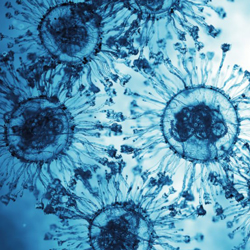Stranger Things in the Mechanobiology of Cellular Self-Organization
 Tissue morphogenesis in both embryos and engineered in-vitro models, such as organoids and organs-on-chips, is driven by a combination of biochemical and mechanical signals. During the latter half of the 20th century, the rise of molecular biology and genetics shifted the focus of developmental biologists toward genes and molecular pathways, a trend fueled by the powerful tools these fields offered for testing causal hypotheses. However, over the past two decades, advances in techniques to measure and manipulate tissue mechanics have reignited interest in the mechanobiology of cellular self-organization.
Tissue morphogenesis in both embryos and engineered in-vitro models, such as organoids and organs-on-chips, is driven by a combination of biochemical and mechanical signals. During the latter half of the 20th century, the rise of molecular biology and genetics shifted the focus of developmental biologists toward genes and molecular pathways, a trend fueled by the powerful tools these fields offered for testing causal hypotheses. However, over the past two decades, advances in techniques to measure and manipulate tissue mechanics have reignited interest in the mechanobiology of cellular self-organization.
Today, the focus is on the chemo-mechanical interplay of cells and their environment during morphogenesis, driven mainly by the available experimental and computational tools. New genome editing tools offered transgenic animals or human stem cells with desired genetic mutations and/or reporters. New microscopes enabled imaging of embryonic development with minimal interference. New -omics methodologies and analyses allowed unprecedented access to the molecular underpinning of morphogenesis. New fabrication techniques facilitated the creation of in-vitro environments that better mimic the naturally occurring ones. Better computational frameworks allowed us to integrate all this experimental evidence into cohesive models of morphogenesis. In the process, we often realized that these models had been theorized in the past but were discarded as fringe, non-canonical ideas.
In this spirit, we present this Special Topic of Biophysics Reviews entitled “Stranger Things in the Mechanobiology of Cellular Self-Organization.” Herein, we seek to collect review papers and original articles that bring forth today’s unconventional ideas, theories, tools, and frameworks as they might become tomorrow’s dogma.
Topics covered include, but are not limited to:
- Developmental biology and in-vitro morphogenesis
- Mathematical and computational modeling
- Data-driven and artificial intelligence methods
- Imaging and experimental manipulation
- Developmental disorders
- Evolutionary biomechanics
Guest Editors
Adrian Buganza Tepole, Purdue University
Alessandro Mongera, University College London
Biophysics Reviews Editor
Francesco Pasqualini, Università di Pavia
